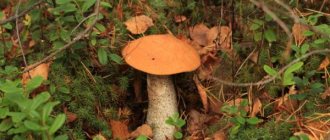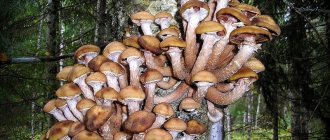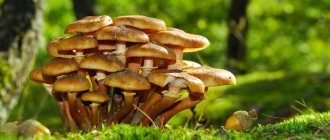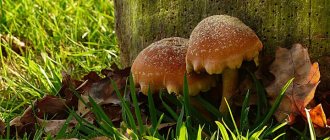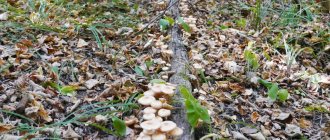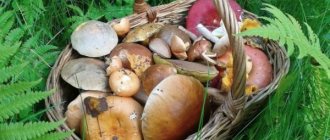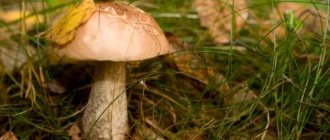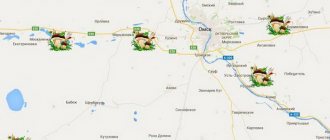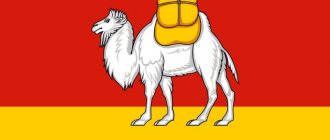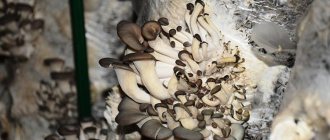Mushrooms in the Tula region 2022 calendar, map, latest reviews - where is the best place to collect, what mushrooms to watch out for, a map of good places and reviews about “silent hunting”. Mushroom picker calendar from May to November.
Those who were born in the Tula region are lucky - in Russia this is truly an ideal place for trips to pick mushrooms, which are found here from early spring to late autumn.
Comprehensive information is collected here for those Tula residents who are too lazy to read kilometers of forums, walls in communities, leaf through directories, and so on. All in one place. Don't thank me.
Edible mushrooms of the Tula region
In the forest, under last year's leaves, mushroom pickers in Tula and the Tula region find edible plants:
- morels;
- lines;
- May;
- field champignons;
- birch sponges.
Oak and birch sponges grow on missing trees, but have a strong aroma and are unpretentious. Champignons delight until November.
Mushroom places on the map of the Tula region.
By summer, the mushroom places of the Tula region are replenished with new species. Grows up:
- boletus;
- White mushroom;
- boletus;
- loader;
- chanterelles;
- white milk mushrooms;
- pigs
- oyster mushrooms
A map of mushroom places in the Tula region shows which plants mushrooms are friends with and which they prefer to stay away from. All traditionally collected forest organisms characteristic of Russia are found in these forests. Summer species are replaced by autumn mushrooms of the Tula region.
Their home is coniferous and mixed forests. Some grow in well-lit edges, while others love partial shade and hide in the slums of the forest. Honey fungus grows on fallen trees and stumps, porcini mushroom and boletus grow in birch groves or in the shade of oak trees, and oiler hides under a dried leaf under a spruce tree.
From the last days of August until the onset of frost, autumn russula begins. They are easy to collect near Christmas trees or pine trees. Umbelliferae, which appear after the 20th of August, are collected in birch groves, on the illuminated edges of the forest.
Mushroom picker calendar
When can you pick mushrooms? The main season lasts from early May to late October. But, given that the weather has become very unstable in recent years, shifts of 2-4 weeks are possible.
Last year, many people collected morels already at the end of April, and in November, before the first serious snowfalls, they brought home baskets with winter honey mushrooms.
Mushroom calendar in the Tula region 2022:
| Month | Mushrooms |
| April | May mushroom, lines, morels |
| May | Lines, oyster mushrooms, May mushrooms, honey mushrooms, boletus mushrooms, morels, russula. |
| June | May mushroom, honey mushrooms, boletus, boletus, chanterelle, fly mushroom, russula, oyster mushroom, boletus, puffball. |
| July | White mushrooms, aspen mushrooms, boletus mushrooms, honey mushrooms, boletus mushrooms, boletus mushrooms, saffron milk mushrooms, chanterelle mushrooms, oyster mushrooms, bitter mushrooms, silver mushrooms, goat mushrooms, violin mushrooms, milk mushrooms. |
| August | Oyster mushrooms, honey mushrooms, white mushrooms, russula, moss mushrooms, boletus mushrooms, mushrooms, milk mushrooms, valui, volushki, champignons, violin mushrooms, autumn honey mushrooms, boletus mushrooms, aspen mushrooms, row mushrooms, goat mushrooms and so on. |
| September | Same as in August, except violin (rare). |
| October | Oyster mushrooms, honey mushrooms, white mushrooms, greenfinches, silver mushrooms, row mushrooms, boletus mushrooms, moss mushrooms. |
| November | Autumn and winter honey mushrooms, row, goat, oyster mushroom. |
In the warm autumn at the beginning of November, you can even find porcini mushrooms or russula, especially in clearings warmed by the sun. And at the end of the month, the most extreme people collect oyster mushrooms or honey mushrooms from under the snow.
The best months for picking mushrooms are August and September. If the summer is rainy, then in July you can get a full basket. But, again, a lot depends on the gathering places and the weather.
Map of mushroom places
It is impossible to show specific places in the Tula region, and it is stupid to do so. As soon as information is received that there are a lot of mushrooms in such and such a forest, hundreds of pickers rush there, mercilessly cut off the mycelium, and then it is almost impossible to find anything in this place, even for several years. However, there are guidelines for assembly. The main places for collecting mushrooms in the Tula region are the northern part. In the south, mushrooms are also found in forest belts, but mostly puffballs, sometimes morels.
Finding a suitable forest where you can pick mushrooms in the Tula region is quite easy - follow the satellite to the most remote area, and off you go. It’s already extremely difficult to find anything near cities. Prilepy, Mordves, Yasnogorsk, Dyadilovskie settlements, Aleksandrovka, Botnya, Senevo, Tarusa, Strakhovo are the most popular destinations for “silent hunting”. The ideal option for travel is, of course, a car or a bicycle, but you can always get there by public transport, bus or train.
Dyadilovskie settlements
Before collecting, it is important to prepare, talk with mushroom pickers who have their own map of mushroom places in the Tula region. To harvest a large harvest, it is better to go after a good rain. According to the map of mushroom places in the Tula region, unique places are located in the forests near Suvorov. It’s easy to get there: from the Moskovsky train station you take a Tula-Belev diesel engine to Khanino. In the pine forest near Aleksin there are a huge number of russula and trumpets. A regular bus or minibus from the Tula bus station will take you to the city.
The Tula-Dubna minibus will take you to the forests of Dubna. The journey takes 30-40 minutes. A rich harvest of boletus, porcini and aspen mushrooms is harvested there. There are mushroom places in the Tula region near the city of Efremov. You can easily get to the forests of Efremov by bus or by minibus Tula-Efremov. Within an hour they reach the beautiful mixed forests of the area, where they find not only mushrooms, but also strawberries, nuts, and raspberries. The forests here are dense and there are wild animals - it’s better not to walk alone.
Near Tula, in the Chernsky, Yasnogorsky and Leninsky districts, a large number of edible mushrooms grow. In the Belevsky and Arsenyevsky districts, mushroom pickers collect environmentally friendly harvests. Mushrooms in the Tula region for 2022 are characterized by a large number of edible varieties. Everyone who wants to collect them for canning and fresh consumption goes to this region. You can get to Tula from Moscow in 2-3 hours. Make a list of mushroom places in advance to make the “quiet hunt” easier.
Latest reviews
So, about mushrooms in the Tula region 2022, fresh reviews from first-hand sources. All information was collected from the community on VK, forums, verified and accurate.
“For many years we collected in Prilepy, walked from Tula to Serebryanye Klyuchi. But both the village and the Shcheglovskaya zaseka - everything has recently become quite dirty and crowded. Although you can gain some money there, especially after prolonged rains, when not many people go into the forest. This year we started exploring the Dubensky district and really liked it. They returned straight from spring with morels, if you go further from Guryevka to the reserve, in the islands you come across a lot of boletus, boletus and even white boletuses, all clean, without a single worm. There are boletus in the prison, but people are already arriving there.”
“The most normal place for mushroom hunting in the Tula region is Bobrovka and Gerasimovo. Honey mushrooms, boletus mushrooms, and if you’re lucky – white ones. In the fall, we collected full baskets of oyster mushrooms, knife to stick, and went ahead to milk the stumps. I advise you to go along the power lines and look in the forest itself. It’s still beautiful there, although it’s a little far to drive, but it’s worth it.”
“Where to pick mushrooms near Tula? The villages of Rassvet and Stukalovo, or better yet, take 70K-041 a little further to Sloboda. Not bad places, although there are people, it’s better to go before the weekend. Honey mushrooms can be found in the fall, but you have to look under the leaves. In the summer there is an abundance of russula, and recently we have had a good selection of boletus mushrooms.”
“In the summer we went to the Osetrovskoye forestry, but found little. This year we went from the road through Zasechny and gained a lot of ground. In general, mushrooms grow well in Zaseki, especially where there are hilly areas, in the lowlands. Chanterelles, honey mushrooms, boletus, a little bit of everything.”
“I want to talk about a trip to pick mushrooms in Selivanovo, Shchekovsky district. The most beautiful places, abandoned temples, unspoiled and pristine forests, and most importantly, there are plenty of mushrooms, they are collected with excitement, and there are few people. Nearby there is the Kryukovskoye forestry, the Upa River with fishing, in general, the places are fabulous. In two hours - three buckets, in the spring there are plenty of morels. Mushrooms can be collected until November. Along the edges of the forest, of course, even small things are torn out, but a little further, it’s very good.”
“Yasnaya Polyana today, from 7 a.m. to lunch, two buckets of honey mushrooms. We won’t go again because it’s crowded with tourists and school kids. If you just take a walk. But along the road we spotted a couple of places with dense forest, so we’ll go there for reconnaissance.”
“I won’t name specific places. There is nothing in Krapivna; further away in Prokudino there are super cool clearings. But we have to look. In general, the Upa River is a godsend for mushroom pickers, so ride along it, you will find a lot of things, and if there is also a Niva or UAZ, then you certainly won’t be left without mushrooms.”
“We were in the Tula region, we heard a lot of new things, such names of mushrooms are scaly, dungeons, govorushka, row, here near Kaluga all this is considered even unethical to take. The places are beautiful, we were in the museum in Yasnaya Polyana, but there are no mushrooms, because all that was left from the forests were stubs.”
Fresh reviews about mushrooms in the Tula region 2022 and good places will be updated constantly as information becomes available. Write comments!
- Author: Maria Sukhorukikh
Rate this article:
- 5
- 4
- 3
- 2
- 1
(0 votes, average: 0 out of 5)
Share with your friends!
When does mushroom season start?
Along with edible ones, poisonous ones also appear, such as pale toadstools and fly agarics. Rospotrebnadzor warns: do not pick an unfamiliar mushroom. It is also not recommended to collect them along highways due to the absorption of toxins and heavy metals from exhaust gases. You should go for mushrooms in the Tula region in mid-June. Then their number and variety increases. Chanterelles, milk mushrooms, honey mushrooms appear, and even champignons can be found in forest clearings.
Read more:
Where to donate excess mushrooms
Read more:
The earliest spring mushrooms
Read more:
How to distinguish an edible mushroom from an inedible one
White
Almost all porcini mushrooms collected in our latitude grow in the fall - you don’t even need to look in reference books to confirm this fact. However, in the summer they are observed to produce the most massive amounts of fruit, and in the fall (until about October ) they are seen less frequently. But they are still collected at this time, and the further south the region, the more often and for longer. There are several varieties of porcini mushrooms that form mycorrhiza with different trees - birches , pines , spruces , oaks and others. You can read more about the places where porcini mushrooms grow in the article “Where porcini mushrooms grow.”
Are there honey mushrooms in the Tula region and where to look for them?
Where do autumn honey mushrooms grow in the Tula region, and which forests can you go to for them? The most popular area among the local population is the Suvorovsky district. Forests near the settlements of Suvorovo, Khanino and Chekalino are especially called mushroom forests. Forests near the village of Spitsino, as well as near the village of Ozerny, are considered mushroom places for the spread of honey mushrooms in the Tula region. In the broad-leaved and pine forests located in the Aleksinsky district near the village of Aleksino, you can collect not only honey mushrooms, but also chanterelles, russula, and boletus.
All fruiting bodies prefer to “cooperate” with certain plants. Therefore, every mushroom picker knows where to look for honey mushrooms in the Tula region. These mushrooms prefer birch, linden, acacia, ash, oak trees, and are less commonly found in pine forests. Sometimes even the roots of shrub plants can select honey mushrooms. However, the trees on which they settle are dying or “sick”. Honey mushrooms give great preference for their settlement to rotten stumps, tree trunks knocked down by windbreaks or fallen branches.
Many novice mushroom pickers ask if there are honey mushrooms in the Tula region in the Leninsky district? In the area of the village of Demidovka, in the broad-leaved forests you can find autumn mushrooms, as well as saffron milk caps and boletus mushrooms. The Dubensky district in the Tula region is rich in “Assumption” honey mushrooms. There are a lot of mushrooms in these broad-leaved forests, where birches and oaks predominate, especially since these trees are located in wetlands. The ravines in this area are replete with meadow mushrooms.
Forest areas where there are honey mushrooms in the Tula region and Tula
A good harvest of honey mushrooms is being collected in the Tula region in the protected forests “Tula Zaseki” and “Yasnaya Polyana”. The Tula forestry is also famous for places where species grow en masse. Forests for “silent hunting” are located in the Prioksky, Zasechny, Odoevsky districts. Forests - Central forest-steppe, South-Eastern, Northern.
Where do autumn honey mushrooms grow in the Tula region and Tula?
If autumn honey mushrooms appear en masse in Tula, they are sent to the following areas:
- Dubensky, where oaks and birches grow;
- Suvorovsky, to the settlements of Khanino, Suvorovo, Chekalino;
- Leninsky, to Demidovka in deciduous forests;
- Shchelkinsky is a massif near the village of Spitsino.
And also in the village of Ozerny, Tula Urban District.
Where do they grow?
Usually chanterelles prefer mixed forest. The soil suitable for them is sandy, moist, rich in moss. It also grows on swamp hummocks. When searching, you should pay attention to both open clearings and forest edges.
Also find out where chanterelles grow in the Leningrad region.
If you find a clearing of birches, carefully examine it; they are often found in such places. Mushrooms may be hidden by grass or fallen leaves, especially in the fall, be sure to check hidden places. Don't be afraid to lift the moss; mushrooms may be hiding under it.
Video: Where and how chanterelles grow
Weather for a good mushroom harvest
Honey mushrooms begin to grow actively only with high soil moisture and temperature conditions:
- in spring not lower than +12 0C;
- in summer +23 0C;
- in autumn +15 0C.
In dry summers there is no need to expect a high harvest. Spring and summer honey mushrooms grow after rains at constant air temperatures. The fact that autumn honey mushrooms have appeared en masse in the Tula region is determined by the precipitation map for 2022. After the rains, fruiting bodies are formed in 3 days. Mass collection occurs on warm days, when there is no sharp drop in temperature at night.
View recipes:
Salted and pickled mushrooms, preservation and preparations
View recipes:
Mushroom dishes: festive and everyday
Hedgehogs
Photo 15. Rufous hedgehog. Author: H. Krisp.
Their distinctive feature is unusual needle-like spines on the underside of the cap, instead of the usual plates or tubes.
Photo 16. Variegated hedgehog is a conditionally edible summer-autumn mushroom. Author: H. Krisp.
These mushrooms grow just as well in the fall as in the summer and can last until the first cold weather. They are found in different forests, because they can form mycorrhiza with various trees - both deciduous and coniferous.
Photo 17. Notched hedgehog. Photo by: Bubulcus.
In our country, hedgehogs are not collected everywhere, but in Europe they are considered very edible, and one of the species, the variegated hedgehog , is used as a seasoning.
Saffron milk caps
There are about a dozen varieties of saffron milk caps, and almost all of these mushrooms grow in the fall, most of them also appear in the summer. A separate article is devoted to all of them: “Where saffron milk caps grow: forests, places and times of collection.” Here, as an example, I will consider a typical species, the most widespread and popular among mushroom pickers.
The saffron milk cap is real
An autumn-summer mushroom that forms mycorrhiza with pine and loves young forests. It is found both in June and October , including before the appearance of stable snow cover. But camelina bears fruit en masse in mid-summer , and especially in early autumn .
